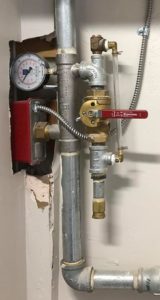To Cite or Not to Cite – Evaluating Installation in NFPA 25
Conducting an evaluation of a sprinkler system design or installation is outside the scope of NFPA 25, The Standard for Inspection, Testing, and Maintenance of Water-Based Fire Protection Systems. In this blog we will explore what NFPA 25 says about testing of components and devices through the owner’s evaluation section (4.6.1).When a main drain test cannot be conducted because the drain will not handle the full flow, does this qualify as an installation issue or can it be cited on an inspection and testing report? It is commonly not cited because it was approved or accepted by an Authority Having Jurisdiction (AHJ). Does this mean it shouldn’t be cited? This question is also the same for testing flow switches when there is not a proper inspector’s test connection.
Waterflow Switches
We will start with testing waterflow switches. For many cycles of NFPA 25, Chapter 5 states that waterflow switches must be tested at a specific interval. In earlier editions the requirement was quarterly. Since the 2008 edition, the requirement is semi-annually. It does not state that the switches must operate in a specific time, nor does NFPA 25 say that the switch must work at all. Of course, this does not mean that the waterflow alarms do not have to operate, it just does not state specifically that they do.
Inspector’s Test Connection
Before we continue, let us look at what a proper inspector’s test connection is. Most people in the fire sprinkler industry know that the size of the orifice in the inspector’s test connection must be the same size as the smallest orifice or K-factor sprinkler installed in the system. However, until the 2017 edition of NFPA 25 it was never stated. NFPA 25 only stated that testing of the waterflow alarms was to be accomplished by opening the inspector’s test valve. In the 2017 edition specific language was added requiring an orifice the same size as the smallest K-factor sprinkler to be used in the inspector’s test connection. There are many installations without proper inspector’s test connections installed and many that are not piped to a suitable drain. Therefore, the waterflow alarms cannot be properly tested. Many times, this is noted on an observation report but not cited.
Installation and Testing
Section 4.6.1 of NFPA 25 states that components and systems shall be tested to ensure they function as intended. How can a waterflow alarm be tested properly if it is not properly installed? It cannot. However, using section 4.6.1 as an inspector citing this installation issue may be possible. The same can be said for when a main drain test is not piped to a suitable drain to handle full flow. Section 16.10.4.6 of NFPA 13, 2019 edition states that the main drain test connection shall be piped to a location that will permit full flow tests. If main drains are not piped to a suitable location the test cannot be performed, once again not meeting the requirements of NFPA 25, specifically Section 4.6.1.
Installation Flaws and Testing Through NFPA 25
The examples used in this blog could be considered installation flaws, but when the installation flaw does not allow for proper testing, something needs to be done to correct them. Section 4.6.1 clearly states that all systems and components shall be tested to ensure they function as intended. This is not the same as conducting a visual inspection and citing missing or improperly spaced sprinklers. This is directly related to the function of the systems or components and should be cited when found.


